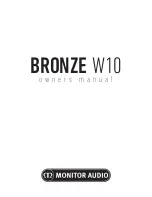
17
18
Low-level connection (via phono connectors) is always an option if high-level connection is not possible.
When connecting to the low-level inputs in a system in which high-level connection is not possible, such as
if using internally-amplified speakers, connect left and right phono cables between the LOW LEVEL INPUT
jacks of the REL and the left and right channel outputs of your preamplifier.
When connecting to a home cinema system where there is a .1/LFE channel output, connect a single phono
cable between the sub output of the processor/receiver and the .1/LFE input jack on the REL.
1 Positioning:
The optimal position for a REL is in one of the corners behind the main speakers. This position
provides 9 dB of mechanical amplification and allows for the most linear true low bass wave launch, owing
to the ability to tune the REL to the longest distance in the room in order to produce the longest, therefore
lowest, bass waves.
2 The Process:
To begin the set-up process, choose a piece of music that has a repetitive bass line that is
very low in frequency. We suggest track 4 from the soundtrack to Sneakers (Columbia CK 53146). This has
a repetitive bass drum throughout that gives you plenty of time to move the woofer around, but more
importantly, the venue was quite large for this recording, and therefore it has a very deep and large-scale
bass signature. This type of track is perfect for the set-up process and should be played at the highest
reasonable level expected for system playback.
Working with a partner, one in the listening position and one at the REL manipulating the controls, is the
most effective and efficient way to set up the REL. If working alone, the initial steps in the set-up can be very
effectively carried out from the location of the REL. Trying to ignore all other music in the track, listen for
the bass drum and its effect on the listening room.
3 Phase Orientation:
Once in the corner we need to adjust for phase. This may be the single most critical step,
and because it really is quite simple, it is often over-thought. Keep in mind; the right phase is whichever
position is the loudest or fullest. While playing music with true low bass, adjust the crossover to a point
where the REL and the speaker are sure to share frequencies (about halfway up, or at 12 o’clock on the
crossover control, or slightly higher for smaller speakers). At this point turn the HI/LOW LEVEL control up so
that both the REL and speaker are roughly equal in volume and then switch, using the phase switch, from
“0” to “180” phase positions. Again, whichever position is loudest or fullest is the correct position. That is,
when the position is working in harmony with your main speakers, reinforcing bass, not cancelling it.
4 Placement:
The next step is to determine precisely how far from the corner the sub should be placed to
achieve the most efficient output, as well as the lowest frequency extension. With the REL fully into the
corner, and pointing straight out along the diagonal coming out of the corner, continuing to play the music,
slowly pull the REL from the corner on the diagonal, equidistant from both side and rear wall. At a certain
point (sometimes a matter of only a few inches, in rare cases a foot or more) the REL will audibly go lower,
play louder, and, if it truly locks on to the room and is fully pressurizing it, the air around the REL will seem
to be energized, stop right there! This is the correct position from the corner for the REL.
5 Orientation:
Once the position from the corner has been established, the orientation of the woofer
must be determined by rotating the REL from an imagined centre point at the rear of the REL. As the REL is
moved from one side to the other listen for the greatest level of output and bass linearity. In effect, the REL
should be left in the position where it is playing the loudest and lowest.
6 Crossover and Level Settings:
To determine the crossover point, take the volume of the REL (using the
HI/LO Level control) all the way down, and put the crossover to 30 Hz. At this point, bring the REL’s volume
back up slowly to the point where you have achieved a subtle balance, i.e. the point at which you can hear
the REL even with the main speakers playing. Now, bring the crossover point up until it is obviously too
high; at this point bring it down to the appropriate lower setting. For all intents and purposes, this is the
correct crossover point. Once this stage has been reached, subtle changes to volume and crossover can be
accomplished to provide the last bit of complete and seamless integration. With that, set-up is complete.
Hint:
There may be a tendency to set the crossover point too high and the volume of the Sub-Bass System
too low when first learning how to integrate a REL with the system, the fear being one of overwhelming the
main speakers with bass. But in doing so, the resulting set-up will be lacking in bass depth and dynamics. The
proper crossover point and volume setting will increase overall dynamics, allow for extended bass frequencies,
and improve soundstage properties. Note, volume must be adjusted in conjunction with crossover changes.
In general, when selecting a lower crossover point, more volume may need to be applied.
Содержание T/i Series
Страница 1: ......
Страница 15: ...25 26 Notes...

































